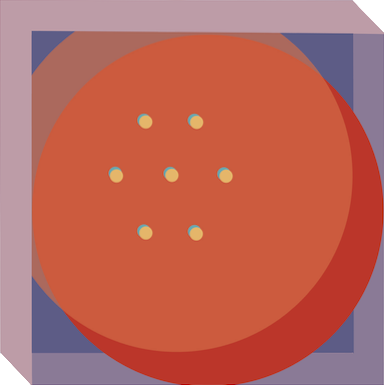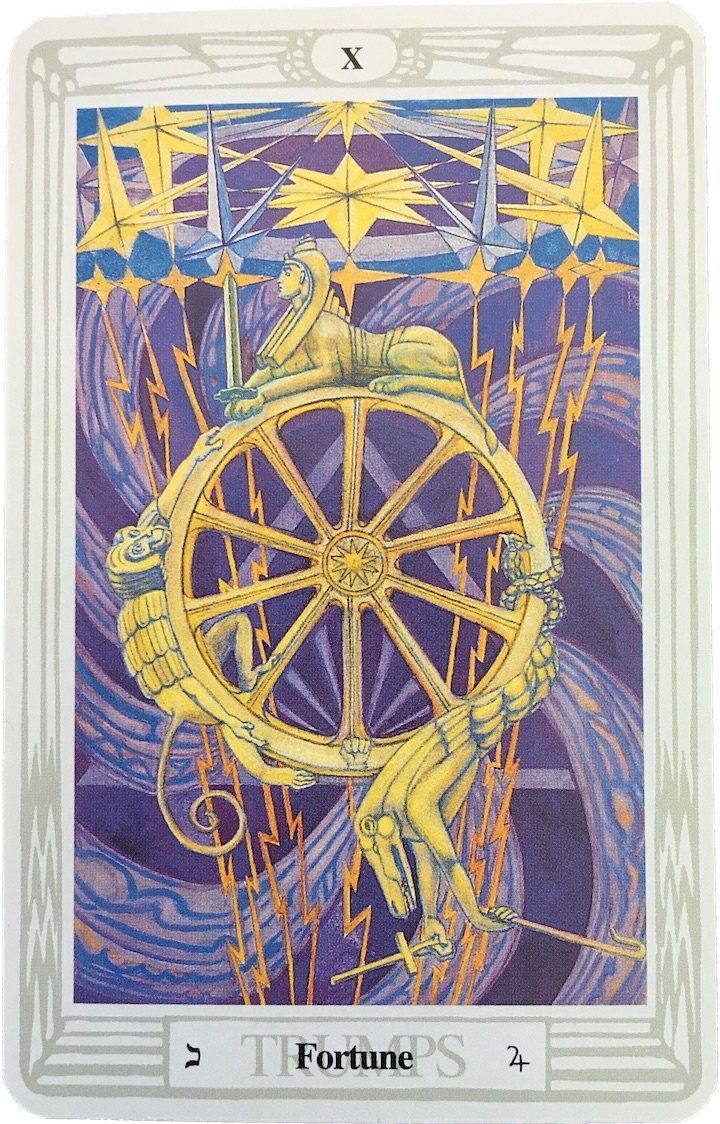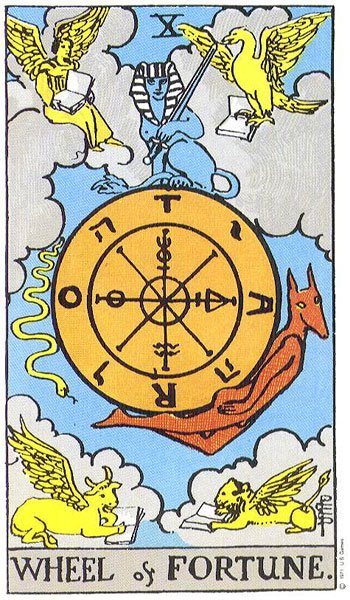FORTUNE : KEY X (The Wheel of Fortune)
Alesiter Crowley
This card is attributed to the planet Jupiter, “the Greater Fortune” in astrology. It corresponds to the letter Kaph, which means the palm of the hand, in whose lines, according to another tradition, the fortune of the owner may be read. [Kaph 20 Peh 80 =100, Qoph, Pisces. The initials K Ph are those of kteiV and falloV] It would be narrow to think of Jupiter as good fortune; he represents the element of luck. The incalculable factor.
On this wheel are three figures, the Sworded Sphinx, Hermanubis, and Typhon; they symbolize the three forms of energy which govern the movement of phenomena.
The nature of these qualities requires careful description. In the Hindu system are three Gunas-Sattvas, Rajas and Tamas. The word “Guna” is untranslatable. It is not quite an element, a quality, a form of energy, a phase, or a potential; all of these ideas enter into it. All the qualities that can be predicated of anything may be ascribed to one or more of these Gunas: Tamas is darkness, inertia, sloth, ignorance, death and the like; Rajas is energy, excitement, fire, brilliance, restlessness; Sattvas is calm, intelligence, lucidity and balance. They correspond to the three principal Hindu castes.
One of the most important aphorisms of Hindu philosophy is:
“the Gunas revolve”. This means that, according to the doctrine of continual change, nothing can remain in any phase where one of these Gunas is predominant; however dense and dull that thing may be, a time will come when it begins to stir. The end and reward of the effort is a state of lucid quietude, which, however, tends ultimately to sink into the original inertia.
The Gunas are represented in European philosophy by the three qualities, sulphur, mercury and salt, already pictured in Atu I, III and IV. But in this card the attribution is somewhat different. The Sphinx is composed of the four Kerubs, shown in Atu V, the bull, the lion, the eagle and the man. These correspond, furthermore, to the four magical virtues, to Know, to Will, to Dare, and to Keep Silence. [These are the four elements, summed in a fifth, Spirit, to form the Pentagram; and the Magical Virtue corresponding is Ire, to go. “To go” is the token of Godhead, as explained in reference to the sandal-strap or Ankh, the Crux Ansata, which in its turn is identical with the astrological symbol of Venus, comprising the 10 Sephiroth.(See diagram)]. This Sphinx represents the element of sulphur, and is exalted, temporarily, upon the summit of the wheel. She is armed with a sword of the short Roman pattern, held upright between the paws of the lion.
Climbing up the left-hand side of the wheel is Hermanubis, who represents the alchemical Mercury. He is a composite god; but in him the simian element predominates.
On the right hand side, precipitating himself downward, is Typhon, who represents the element of salt. Yet in these figures there is also a certain degree of complexity, for Typhon was a monster of the primitive world, personifying the destructive power and fury of volcanos and typhoons. In the legend, he attempted to obtain supreme authority over both gods and men; but Zeus blasted him with a thunderbolt. He is said to be the father of stormy, hot and poisonous winds; also of the Harpies. But this card, like Atu XVI, may also be interpreted as a Unity of supreme attainment and delight. The lightnings which destroy, also beget; and the wheel may be regarded as the Eye of Shiva, whose opening annihilates the Universe, or as a wheel upon the Car of Jaganath, whose devotees attain perfection at the moment that it crushes them.
Joan Bunning
The Wheel of Fortune is one of the few cards in the major arcana that does not have a human figure as a focal point. This is because its center is above the realm of man – in the higher levels (clouds) where the destinies of all are woven together in the tapestry of life. The tarot recognizes that each person sets his own path in life, but is also subject to the larger cycles that include him. We experience chance events that appear to be accidents although they are part of the great plan.
In readings, the Wheel of Fortune can indicate a vision or realization that strikes with great force. If you’ve been struggling with a problem or tough situation, this card can signal that you will find the answer if you stand back and view everything from a larger perspective.
The Wheel of Fortune also represents unexpected encounters and twists of fate. You can’t predict surprises; you can only be aware when one is circling around. Indeed, Card 10 often suggests wheel-like actions – changes in direction, repeating cycles and rapid movement. When the energy of the Wheel arrives, you will feel life speed up. You are caught in a cyclone that may deposit you anywhere. “Round and round and round she goes, and where she stops, nobody knows.”
FEELING A SENSE OF DESTINY
seeing life’s threads weave together
finding opportunity in an accident
opening to luck
sensing the action of fate
witnessing miracles
BEING AT A TURNING POINT
moving in a different direction
turning things around
having a change in fortune
altering the present course
being surprised at a turn of events
FEELING MOVEMENT
having the tempo of life speed up
being swept up in new developments
rejoining the world of activity
getting involved
HAVING A PERSONAL VISION
becoming more aware
uncovering patterns and cycles
expanding your outlook
gaining greater perspective
discovering your role and purpose
THE WHEEL OF FORTUNE’S ROLE IN THE FOOLS JOURNEY
After much soul-searching, the Fool begins to see how everything connects. He has a vision of the world’s wondrous design; its intricate patterns and cycles. The Wheel of Fortune (10) is a symbol of the mysterious universe whose parts work together in harmony. When the Fool glimpses the beauty and order of the world, if only briefly, he finds some of the answers he is seeking.
Sometimes his experiences seem to be the work of fate. A chance encounter or miraculous occurrence begins the process of change. The Fool may recognize his destiny in the sequence of events that led him to this turning point. Having been solitary, he feels ready for movement and action again. His perspective is wider, and he sees himself within the grander scheme of a universal plan. His sense of purpose is restored.
A.E. Waite
Wheel of Fortune
In this symbol I have again followed the reconstruction of Éliphas Lévi, who has furnished several variants. It is legitimate–as I have intimated–to use Egyptian symbolism when this serves our purpose, provided that no theory of origin is implied therein. I have, however, presented Typhon in his serpent form. The symbolism is, of course, not exclusively Egyptian, as the four Living Creatures of Ezekiel occupy the angles of the card, and the wheel itself follows other indications of Lévi in respect of Ezekiel’s vision, as illustrative of the particular Tarot Key. With the French occultist, and in the design itself, the symbolic picture stands for the perpetual motion of a fluidic universe and for the flux of human life. The Sphinx is the equilibrium therein. The transliteration of Taro as Rota is inscribed on the wheel, counterchanged with the letters of the Divine Name–to shew that Providence is imphed through all. But this is the Divine intention within, and the similar intention without is exemplified by the four Living Creatures. Sometimes the sphinx is represented couchant on a pedestal above, which defrauds the symbolism by stultifying the essential idea of stability amidst movement.
Behind the general notion expressed in the symbol there lies the denial of chance and the fatality which is implied therein. It may be added that, from the days of Lévi onward, the occult explanations of this card are–even for occultism itself–of a singularly fatuous kind. It has been said to mean principle, fecundity, virile honour, ruling authority, etc. The findings of common fortune-telling are better than this on their own plane.


